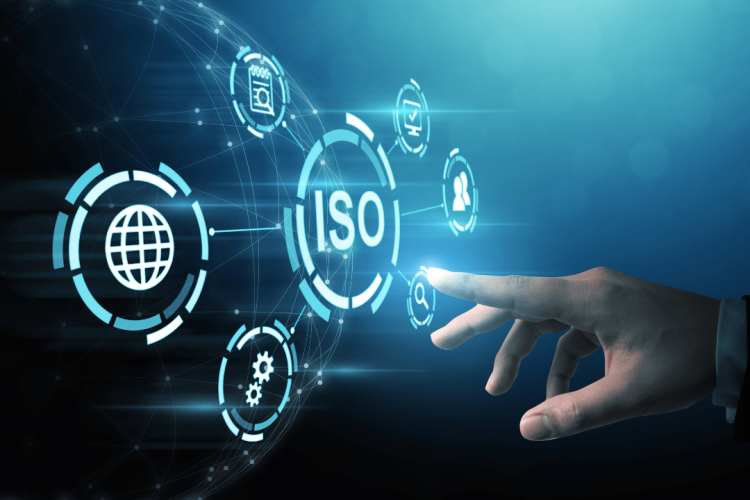ISO 27001 is the leading international standard focused on information security that delineates a systematic approach to managing information security risks. At its core, ISO 27001 offers a structured framework for designing, implementing, monitoring, and continuously improving an Information Security Management System (ISMS) in a cost-effective way. This system is designed to protect the confidentiality, integrity, and availability of sensitive information.
Structure of ISO 27001
ISO 27001 is structured into two main parts, each serving a distinct purpose in guiding organisations towards comprehensive information security practices:
Main Part: Clauses 0 to 10
The first part of ISO 27001 consists of 11 clauses (numbered 0 to 10), each addressing specific aspects of the standard. Clauses 0-3 outline general information about ISO 27001, and 4-10 are mandatory requirements that your organisation must comply with to be certified:
Introduction (Clause 0): Provides an overview of the standard and its purpose, setting the context for the subsequent clauses.
Scope (Clause 1): Defines the scope of the standard’s applicability within an organisation.
Normative References (Clause 2): Lists the references to other standards that provide essential context for ISO 27001.
Terms and Definitions (Clause 3): Clarifies the key terminology used throughout the standard.
Context of the Organisation (Clause 4): Requires organisations to analyse their internal and external environment to determine the scope of their Information Security Management System (ISMS).
Leadership (Clause 5): Emphasises the role of top management in demonstrating leadership and commitment to information security.
Planning (Clause 6): Outlines the process of risk assessment and risk treatment planning to identify and mitigate potential threats.
Support (Clause 7): Covers resource allocation, awareness training, communication, and documentation requirements.
Operation (Clause 8): Addresses the implementation of information security controls, processes, and practices.
Performance Evaluation (Clause 9): Focuses on monitoring, measurement, analysis, and evaluation of the ISMS’s effectiveness.
Improvement (Clause 10): Requires continuous improvement of the ISMS based on performance evaluation results.
Annex A: Control Objectives and Controls
The second part of ISO 27001 is known as Annex A. It provides guidelines for implementing a set of controls that contribute to information security. Annex A consists of 114 control objectives and controls, categorised into 14 sections, such as “Information Security Policies” and “Access Control.”
Understanding the Relationship: Clauses 4 to 10 of the main part of the standard detail the mandatory requirements for achieving ISO 27001 compliance. Annex A supports these clauses by offering a comprehensive list of controls that organisations can select based on their risk management process. While these controls in Annex A are not mandatory, they play a crucial role in building a robust Information Security Management System.
By integrating the provisions of both the main part and Annex A, organisations can establish a tailored and effective framework for information security that aligns with their unique context and risk landscape.
Why ISO 27001: Benefits For Your Business
The digital landscape is rife with cyber threats and risks. ISO 27001 provides numerous benefits to organisations aiming to fortify their information security posture:
Enhanced Data Protection: ISO 27001 helps organisations safeguard their sensitive information, minimising the risk of data breaches.
Regulatory Compliance: The standard aids in achieving compliance with various industry regulations, such as GDPR and HIPAA.
Client Trust: Demonstrating ISO 27001 compliance enhances clients’ confidence, showcasing your commitment to securing their valuable data.
Efficient Processes: The structured approach of ISO 27001 streamlines security management, resulting in better resource allocation and increased efficiency.
Continuous Improvement: ISO 27001 promotes a cycle of continual improvement, encouraging organisations to stay vigilant against evolving security threats. The standard itself is regularly updated, with new controls added to keep pace with the changing digital landscape.
International Recognition: ISO 27001 is globally recognised, opening doors to international partnerships and collaborations.
ISO 27001 Certification Process: Navigating the Journey
Achieving ISO 27001 certification is a significant accomplishment for any business that involves a well-defined process to build comprehensive information security practices. Let’s break down the key stages:
Scoping
The journey begins with scoping, where organisations define the boundaries and assets that will be covered by their Information Security Management System (ISMS). This step ensures that the ISMS focuses on the areas of the organisation that require robust security measures.
Risk Assessment
A thorough risk assessment follows, aimed at identifying and evaluating information security risks. Organisations analyse potential vulnerabilities and threats to their assets. This assessment is a critical foundation for determining the necessary security controls that will be implemented.
Gap Analysis
Conducting a gap analysis is pivotal for measuring the organisation’s existing information security practices against the requirements of ISO 27001. This step highlights areas where the organisation falls short of the standard’s expectations, guiding the development of a robust ISMS.
ISMS Development
Guided by the insights from the risk assessment and gap analysis, the organisation proceeds to develop and implement its ISMS. This comprehensive system integrates the necessary security controls that are tailored to address identified vulnerabilities and risks.
Internal Audits
Internal audits play a central role in ensuring the effectiveness of the ISMS. These audits are conducted regularly to assess the compliance of the implemented practices with the ISO 27001 standard. They serve as an ongoing evaluation mechanism and offer opportunities for improvement.
Certification Audit
The organisation reaches a pivotal stage where an independent certification audit is conducted. Accredited certification bodies like OmniCyber Security rigorously examine the ISMS’s alignment with the ISO 27001 standard. This audit validates the organisation’s adherence to globally recognised information security practices.
Certification Decision
Upon successful completion of the certification audit, the organisation awaits the certification decision. If the audit verifies the ISMS’s compliance with ISO 27001 requirements, the organisation is awarded the ISO 27001 certification. This certification reflects the organisation’s commitment to maintaining robust information security practices.
The Origins of ISO 27001: Addressing Information Security Challenges
ISO 27001, part of the ISO/IEC 27000 family of standards, was created in response to the growing need for a globally recognised framework that addresses the challenges posed by the increasing digitalisation and interconnectedness of organisations. The standard was developed to provide a systematic approach to managing information security risks and to establish a robust information security management system (ISMS).
- Escalating Threat Landscape: With the rapid advancements in technology, the threat landscape evolved as well. Organisations faced a barrage of cyber threats, ranging from data breaches to ransomware attacks, which could potentially cripple operations and compromise sensitive information.
- Regulatory and Legal Pressures: Governments and regulatory bodies around the world began enacting stringent data protection laws and regulations. Organisations were required to demonstrate compliance with these regulations, necessitating a standardised approach to information security.
- Complex Ecosystems: The modern business landscape involves intricate networks of suppliers, partners, and customers. Securing data and maintaining trust across this ecosystem became increasingly challenging.
- Need for Best Practices: Organisations recognised the need for a structured framework that not only identified security controls but also provided guidelines for their implementation and management.
In response to these challenges, ISO 27001 was introduced to provide a systematic and risk-based approach to information security management. It enables organisations to proactively identify vulnerabilities, assess risks, and implement effective controls to safeguard their sensitive information. ISO 27001’s framework is adaptable to various industries, sizes, and contexts, making it a valuable tool for organisations seeking to fortify their cybersecurity defences.
By creating ISO 27001, the International Organisation for Standardisation (ISO) aimed to establish a globally recognised standard that could serve as a cornerstone for effective information security practices across industries and regions. It not only helps organisations protect their critical assets but also fosters a culture of security awareness and continuous improvement.
Other Key Standards in the ISO 27001 Series
While ISO 27001 serves as the foundation for information security management, the ISO 27k series comprises a collection of complementary standards that further enhance an organisation’s ability to address various facets of information security. These standards collectively contribute to a holistic approach to safeguarding sensitive information and maintaining robust information security management practices.
ISO/IEC 27000: Terms and Definitions
ISO/IEC 27000 lays the groundwork for the ISO 27k series by providing a comprehensive list of terms and definitions. This standard ensures a common language across the series, helping organisations and professionals navigate the intricate realm of information security. Understanding the terminology is essential for the effective implementation of ISO 27001 and other related standards.
ISO/IEC 27002: Guidelines for Control Implementation
ISO/IEC 27002 provides a detailed guide for implementing controls listed in ISO 27001 Annex A. This standard offers practical guidance on how to design, implement, and manage security controls. It addresses a wide range of security aspects, including physical security, access control, cryptography, and more. ISO/IEC 27002 is a valuable resource for organisations seeking a comprehensive approach to security implementation.
ISO/IEC 27004: Guidelines for Information Security Measurement
ISO/IEC 27004 focuses on the measurement of information security effectiveness. It aligns seamlessly with ISO 27001 by offering guidelines for assessing whether an organisation’s Information Security Management System (ISMS) has achieved its objectives. This standard empowers organisations to establish metrics, monitor progress, and continually refine their information security practices.
ISO/IEC 27005: Guidelines for Information Security Risk Management
ISO/IEC 27005 plays a crucial role in risk management, an essential element of information security. This standard provides comprehensive guidelines for conducting risk assessments and effectively managing information security risks. It complements ISO 27001 by offering detailed insights into the complex process of risk identification, analysis, evaluation, and treatment.
ISO/IEC 27017: Information Security in Cloud Environments
With the proliferation of cloud computing, ISO/IEC 27017 steps in to address information security within cloud environments. This standard offers guidelines for organisations and cloud service providers to establish effective security controls tailored for cloud-based operations. ISO/IEC 27017 ensures that organisations can confidently embrace cloud technologies while maintaining robust security practices.
ISO/IEC 27018: Privacy Protection in Cloud Environments
As privacy concerns grow in cloud environments, ISO/IEC 27018 provides guidelines for protecting personal data in cloud services. This standard focuses on safeguarding privacy-related information and offers recommendations for cloud service providers to enhance their privacy protection measures.
ISO/IEC 27031: Business Continuity for ICT
ISO/IEC 27031 bridges the gap between information security and business continuity planning. It provides guidelines for developing business continuity strategies specifically for Information and Communication Technologies (ICT). By aligning information security with continuity planning, organisations can ensure the seamless functioning of critical systems even in times of disruption.
Collectively, these standards offer a comprehensive framework for organisations to establish robust information security practices, address risks, and navigate the complexities of modern technological landscapes.
Securing the Future with ISO 27001
In conclusion, ISO 27001 is not just a certification; it’s a strategic imperative for organisations navigating the treacherous waters of modern information security challenges. By adhering to its comprehensive framework, businesses can bolster their defences, instil trust among stakeholders, and pave the way for sustainable growth in an increasingly interconnected world.
At OmniCyber Security, we understand the complexities of achieving ISO 27001 certification and the value it brings to your business. Our team of experts possesses the knowledge and experience to guide you through every step of the certification journey. If you’re ready to fortify your information security practices, embark on the path to ISO 27001 certification, and join the ranks of organisations that prioritise data protection, reach out to us today. Let’s work together to elevate your information security to unparalleled heights.
Contact us now to explore how OmniCyber Security can support your ISO 27001 certification journey. Your data security matters to us, and we’re here to help you achieve excellence.




